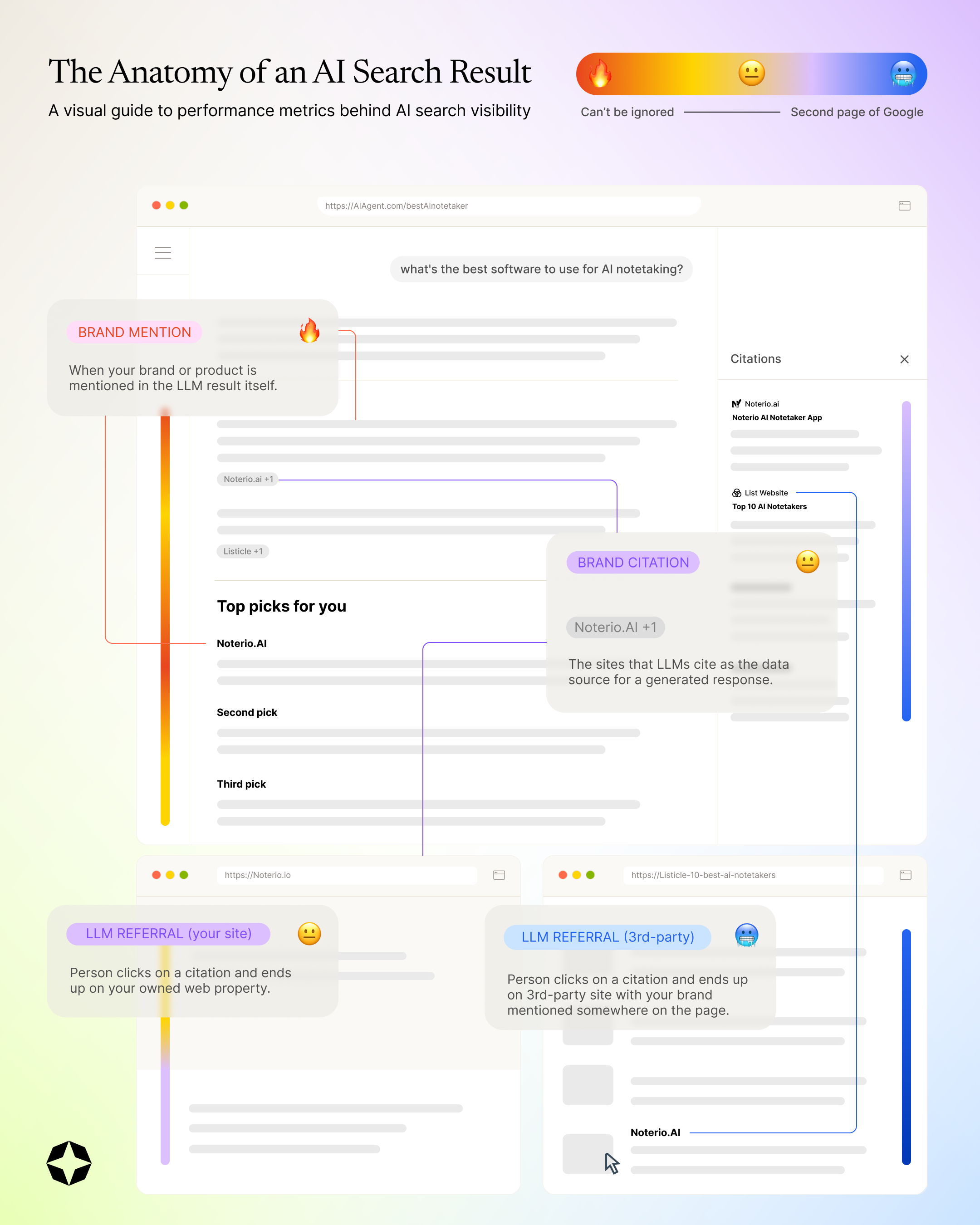Whether you think AI search (aka AEO or GEO) is just SEO rebranded or something entirely new, one thing is clear: the performance metrics have changed.
That’s because the user experience is much different. The biggest difference being that an AI bot, for the most part, does the heavy lifting on behalf of the person behind the prompt.
Contrast that with trad search, where the user is left with the heavy lifting of scrolling, scanning, and deciding what to click
Instead of competing for clicks, you’re now competing for inclusion.
The new goal is simple: when someone asks a relevant question, your brand shows up in the answer.
That shift moves performance away from traffic and rankings toward visibility and influence. In other words: SEO measured who found you; AI search measures whether you’re findable by the AI that finds everyone else.
In this post, I break down the core metrics of AI search, how to track them, and what they tell us. But, you can also see the tl;dr version visually in this handy infographic👇
The anatomy of an AI search result
A visual guide to performance metrics behind AI search visibility

Now, onto the metrics!
Brand presence: how do you know if your brand shows up in AI answers?
In AI search, brand presence is the new “page one.” When an AI includes your company directly in its answer, it’s not just exposure—it’s validation. The model is doing the recommending for you, and the user sees your name in context rather than buried in a results list. That kind of placement builds familiarity and trust in ways traditional search rarely did.
Definition
Brand presence: measures how often your brand or product is mentioned within a set of tracked prompts.
Unit(s) of measurement
📈 Share of voice (%) across relevant prompts: Think of it as share of answer. For a given set of prompts, it measures how often your brand appears.
📈 Brand placement within prompts: Where your brand shows up in the prompt result—top, middle bottom.
Key questions it helps answer (and why)
Do I show up in the answers that matter for my category?
If someone asks “What are the best CRMs for startups?” and your brand isn’t included, that’s a clear visibility gap. Brand presence quantifies whether you’re part of the conversation or missing entirely.
How does my share compare to competitors?
Tracking mentions across prompts gives you a leaderboard of visibility. If one competitor appears twice as often, you know where to focus efforts to close the gap.
Which prompts drive the most mentions?
Prompt-level analysis shows where your brand already resonates. If you appear most often in prompts about integrations or pricing, that’s where you already hold ground.
Likelihood of being seen: 🔥 High
Why: Mentions are embedded directly in the AI’s answer. Users read them as part of the narrative, not as external links to click. Placement near the start or end of an answer tends to draw the most attention, similar to how the top result once dominated a SERP.
––––––––––––
Citations: what are they and how do they influence AI results?
Citations are the connective tissue of AI search. They’re the sources the model draws from to build its answers, shaping what it says and which brands it trusts.
While citations generally get less noticed than a brand mention, it’s arguable they’re a more strategic metric as they influence the LLM response. In other words, to get your brand mentioned, you’re likely going to need to influence the citation by way of your content being cited or getting brand placement on a 3rd-party citation.
Definition
Citations: the external sources an AI model references and uses as an input to generate an answer to a prompt.
Example: the small gray link “pills” beneath the response in ChatGPT
Unit(s) of measurement
📈 Citation share across prompts: How often your domain appears as a cited source across the prompts that matter most.
📈 Citation count: Quantity of citations (or count of your owned cited pages) across the prompts that matter most.
Key questions it helps answer (and why)
Is my content being cited by AI models?
Tracking citations shows whether your content is influencing AI-generated answers. For example, if your “2025 AI search buying guide” appears as a source in ChatGPT or Perplexity, your brand is shaping the narrative.
What are the authoritative sources in my category?
By seeing which domains dominate citations—whether that’s G2, Gartner, or niche blogs—you can identify the content ecosystems AIs trust most. Those are your influence points.
How can I earn or influence citations to improve visibility?
You can’t “optimize” citations the way you can backlinks, but you can publish original data, insights, and research that AI models naturally pull from. Getting cited by trusted third-party sites also increases your indirect influence.
Likelihood of being seen: 😐 Medium
Why: Citations sit one layer below the main answer.
Most users never click them, but LLMs rely on them (especially for RAG responses). They’re what give context and credibility to the brands that end up being mentioned. In other words: citations are how you earn your seat at the table.
––––––––––––
LLM referral traffic: does AI actually drive human visits?
AI platforms aren’t exactly designed to send traffic. But when they do, it’s meaningful. A click from an AI answer isn’t casual; it’s intentional.
The user has already digested the AI’s summary and wants to learn more from the source itself. That makes LLM referral traffic one of the strongest indicators of downstream engagement.
Definition
LLM referral traffic: measures the number of human website visits that originate from AI search engines like ChatGPT, Perplexity, or Bing Copilot.
Example: A human user is prompting ChatGPT, they click on a citation, they reach your site with a referral link that appends ?utm_source=chatgpt.com to the URL counting it as AI referral traffic.
Unit(s) of measurement
📈 Session count from AI domains: The number of visits from chat-based interfaces.
📈 Conversion rate from AI referrals: How often AI-driven sessions result in signups, demos, or other conversions.
Key questions it helps answer (and why)
How much human traffic is coming from AI engines?
Tracking referrals from LLMs shows how often users take the next step to your site. Even a small number proves that AI results can drive measurable demand.
Which prompts or citations drive the most visits?
Mapping referral activity to prompts helps reveal what kind of questions convert. For instance, “best CRM alternatives” tends to generate more clicks than “what is a CRM?” because intent is higher.
Do these visits convert better than traditional organic traffic?
Early data suggests yes. Visitors who arrive from AI engines have been pre-qualified by the model. The AI already decided your brand fits their needs, so the human follow-through is more deliberate.
Likelihood of being seen: 🥶 Low
Why: Most people stay within the LLM user experience. But when someone does click, they’re often much further down the funnel. These visits are fewer in volume but higher in value.
––––––––––––
Agent traffic: how often are AI bots visiting your site?
Before an AI can serve up your content, it has to find your content.
That job belongs to retrieval agents like GPTBot, ClaudeBot, and PerplexityBot. These crawlers act as scouts, fetching data and deciding which pages are worth indexing. Agent traffic is your earliest signal of AI visibility. If bots aren’t crawling you, you’re not even in the consideration set.

Definition
Agent traffic: measures visits from AI retrieval bots that are crawling your site to retrieve an answer on behalf of a user behind the prompt.
Unit(s) of measurement
📈 Bot visit count: How frequently AI bots crawl your website.
📈 Bot diversity: Which AI agents (e.g., GPTBot, ClaudeBot, PerplexityBot) are visiting your site.
📈 Popular bot pages: What pages are most visited by AI bots.
Key questions it helps answer (and why)
How often is my site being considered in AI prompts?
Regular visits from retrieval agents suggest your content is part of the index that powers answers for related queries. It’s a forward-looking visibility metric.
Which AI models or agents are crawling my content?
Knowing which bots hit your site shows where you’re present across the AI ecosystem. Heavy GPTBot activity might mean you’re well-covered by OpenAI, while no Anthropic activity signals a gap.
Is my site technically optimized for AI accessibility?
AI search has its own version of technical SEO. Checking crawl logs and ensuring bots can access your content ensures you’re discoverable to AI systems that rely on structured data.
Track AI traffic on your site with Scrunch We have integrations with Akamai, Cloudflare, Vercel, and Wordpress that make tracking agentic traffic a breeze.
Measure AI search performance with Scrunch
All these metrics—brand presence, citations, LLM referral traffic, and agent traffic—can be measured, improved, and acted on with Scrunch. Try Scrunch free for 7 days OR schedule a demo to see it in action first
